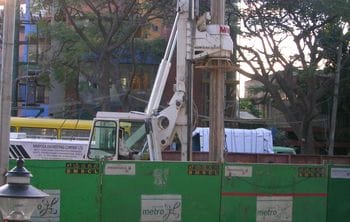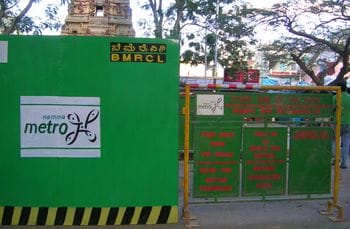Namma Metro’s construction on M G Road has stopped for a couple of weeks, according to a reliable source at BMRCL. This is because a private property next to Nalli Silks on M G Road is under litigation i.e., the owner of the property has a personal litigation going on about the property itself. There is a court stay on the property for two weeks, following which, the construction will begin again.

Ongoing construction is causing noise disturbance for residents living within a few feet of the work. Pic: Zainab Bawa.
On CMH Road also, construction has stopped as of now, until 4 June. The CMH Road Shops and Establishments’ Association, represented pro bono by Pramila Nesargi (MLA-Chamarajpet) had filed a Public Interest Litigation (PIL) on 28 February 2008 against the BMRCL. The traders do no want to relocate out of CMH Road. Their prayer to the court: issue a stay on the construction of the Metro on CMH Road.
PIL against Metro admitted
On 27 March, arguments were traded in Court Hall Number 1 before Chief Justice Cyriac Joseph and Justice B V Nagarathna, on the issue of whether there were sufficient legal grounds to admit the PIL at all. Justice Cyriac Joseph made it clear to Nesargi and the petitioners earlier that the PIL would not be admitted into the High Court unless they pointed out a legal problem with the implementation of the Metro on CMH Road.
The Chief Justice stated that in keeping with the principle of independence of the judiciary from the executive and the legislature, the court will not interfere in matters of policy unless there is a legal problem with the implementation of the policy. "We don’t want to come in the way of the Metro," the Chief Justice pronounced repeatedly in the hearings.
Pramila Nesargi then pointed out that Metro was incompatible with the legislation it was implemented under — the 1906 Tramways Act. "This Act was applicable to the State of Mysore that was in existence at that time. Bangalore then was not the same Bangalore as it is now," she said. The second problem she brought up was that the Metro is a rail system while the tram is a train that runs circular. "You cannot call a rail system a tramway. Call a spade a spade, and not by any other name," she said emphatically.
Continuing on her line on the legal lacuna, Nesargi then pointed out that the DPR (Detailed Project Report) of the Metro itself stated that there is no comprehensive legislation for implementing Metro Rail projects in cities across the country. This DPR, prepared by the DMRC (Delhi Metro Rail Corporation), clearly states that the Centre should enact a comprehensive legislation concerning the implementation of the Metro in cities such as Delhi (for carrying out works for the 2nd phase of the Metro) and Bangalore. The DPR also states that such legislation will be applicable for all metro systems whether wholly implemented by the state and the central governments or in conjunction with private parties, she noted. The Bangalore Metro is being implemented jointly by the Karnataka state government, the central government and a private party.
Nesargi stated that a meeting of the central government had been convened earlier to conceive and enact this legislation, but this was a preliminary meeting and there is no legislation in place yet. She then argued: "When the DPR states that such legislation must exist and when is there is none in place yet, why is the BMRCL in such a tearing hurry to go ahead with the construction?"
In response, Chief Justice Joseph explicitly asked Nesargi, "What if after admitting your case, the Central Government passes the legislation within 20 days? What happens to your petitioners’ case then?" Nesargi replied stating that for now, she is concerned with ensuring that there is rule of law in policy implementation.
The advocate general, B. V. Acharya, arguing for BMRCL, said that the Centre had specifically mentioned that projects implemented within municipal limits are in the jurisdiction of the state government; the Centre will not intervene in matters which the state government is competent to handle. Since the Metro is being implemented within the municipal limits of Bangalore, the state government is the deciding authority, he said.
In their rebuttal to Nesargi’s argument about the absence of a comprehensive legislation, the advocate general stated that in keeping with the decentralization principle, it has been opined that while the Centre would implement the comprehensive legislation, state governments would be free to adapt this legislation to their own conditions.

Pic: Zainab Bawa.
At that point, Chief Justice Joseph commented that there is no comprehensive legislation in the first place.
"So then, should we wait for 20 years until the legislation is created and then begin work for the Metro?" Acharya questioned.
The Chief Justice then admitted the PIL on the grounds of absence of a comprehensive legislation for the implementation of the Metro. Nesargi has been asked to serve a notice to the central government through the Solicitor General. Chief Justice Joseph ordered that the central government should now be called into this case as a respondent. The government advocates have time to file their counterarguments until 4 June, which is the scheduled date for the next hearing.
Meanwhile, the BMRCL cannot carry out any construction on CMH Road.
Compensation not a legal issue in this case
Why is this case not being fought on grounds of inadequate compensation?
When the traders at CMH Road filed the earlier writ petition, they had asked the Judge Manjunath to move the alignment of the Metro from CMH Road to Old Madras Road. The readers will recall that in the earlier story, Citizen Matters had reported that there is an option of aligning the Metro along Old Madras Road instead of CMH Road. But that option has been ruled out by the Shivshankar Bhat committee because of the presence of a mosque, a temple, the Ramkrishna Mission and three graveyards along Old Madras Road.
Aligning the Metro along Old Madras Road would mean acquiring these properties, which in turn would imply harming people’s religious sentiments, according to the Committee. In this PIL, the main prayer is a stay on the construction of the Metro on CMH Road. Readers will also recall that BMRCL is paying compensation to the owners of property along CMH Road and allowances to tenant traders whose shops will be acquired for construction of the Metro. But this compensation, according to property owners as well as the tenant traders, is very poor.
When some of the traders and Nesargi were asked as to why the case was not being fought on the grounds of poor compensation, Nesargi emphatically stated, "Why should I move from my place? I don’t want the compensation."
B N Jagadeesh, a High Court lawyer, explained that if the traders argue on the grounds of poor compensation, it will clearly imply that they are willing to move. The court will then adjudicate that the BMRCL work out an adequate compensation. In the case of CMH Road, traders are unwilling to move because CMH Road is a well-developed commercial hub. The traders argue that moving elsewhere would mean starting all over again and they are simply not interested in that option.
Besides, the property prices in Bangalore are rising considerably, which means added expenses to re-starting their businesses in another area.
Public consultation before implementation
In an earlier hearing, Nesargi had argued that the 1906 Tramways Act requires the state (i.e., the government) to consult in-depth with persons whose properties would be acquired for implementing the Metro. While the government advocates had argued that the consultation had been carried out with the public, the Chief Justice immediately pointed out that the Metro is not being implemented by the state, but by a privately constituted body namely the BMRCL (Bangalore Metro Rail Corporation). This is an important point because the determination of ‘public interest’ was made by the state and central government, and the ‘consultation’ has been done by BMRCL, which is the implementing party itself. The governments of the day did not themselves consult.
The BMRCL, for it’s part, justifies the construction on the basis of 91 per cent approval that it has obtained from a fraction of the citizens of Bangalore in a sample survey. Details about the survey and sampling itself are not available. On the basis of this approval figure, it has been keen to go ahead with the construction.
Leo Saldanha of the Environment Support Group (ESG) pointed out in a public meeting held in June last year, that when the Metro was to be implemented in Boston, the city’s commissioner went door to door, educating the people about the Metro. Citing this example, Leo had asked the BMRCL authorities to take time to study the project and genuinely consult people before initiating the construction.
Current status
At the time of the litigation, BMRCL has begun construction on the perpendicular intersection of CMH Road and Indiranagar 100 ft. Road. Pramila Nesargi stated that this is questionable since the BMRCL has not yet finished construction on M G Road. "What is the big rush then to begin work on 100 ft. Road?"
Nesargi is the sitting MLA of Chamrajpet constituency and is filing her nominations from there for the 2008 state elections. She asserts that gradually, people from different parts of the city will rise in agitation against the BMRCL on issues of acquiring their properties, demolition and displacement, and felling of trees.
Chickpet, which falls in the Chamrajpet constituency, will also have the Metro running through it. It is likely that the traders in this area and in other commercial areas of the city such as K R Market, will protest against the Metro running through their areas. Already, property owners on MKK Road at Rajajinagar where the Metro is slated to come, are unhappy about their situation. According to expert observers, they are waiting for the outcome of CMH Road traders after which they will decide on their course of action.
Construction in the meanwhile is also continuing in all areas covered under the Byappanhalli Road and Mysore Road corridors. ⊕
Related Articles
Nice article on the ground situation. I guess everyone is bothered about their interest being affected. That gains a greater purpose if private interest also serves public need. Today we have one part of 100 feet road completely damaged, flooded with water on the end close to Old Madras Road. In fact, it is the road in front of Nesargi’s house. The work is progressing in a snail pace. Do we expect a high tech city to get caught in such a tangle to just have the public suffer ? Maybe somebody is already doing something about it.